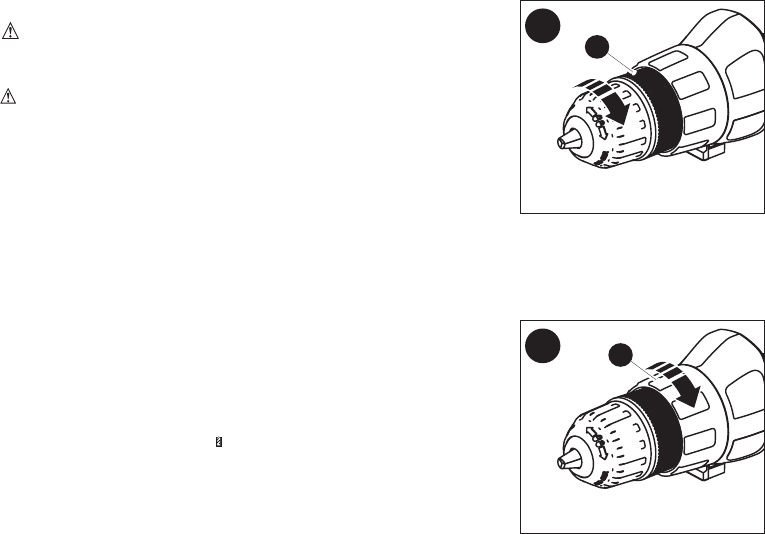
11
KEYLESS CHUCK - FIGURE H
WARNING: To reduce the risk of injury, turn off and
remove battery from the tool before making any adjustments or
removing or installing attachments or accessories.
WARNING: Do not attempt to tighten or loosen drill bits (or
any other accessory) by gripping the front part of the chuck and
turning the tool on. Damage to the chuck and personal injury may
occur when changing accessories.
To insert a drill bit or other accessory:
1. Grasp the rear half of the chuck (12) with one hand
and use your other hand to rotate the front half in the
counterclockwise direction, as viewed from the chuck end.
2. Insert the bit or other accessory fully into the chuck, and tighten securely by holding the rear
half of the chuck and rotating the front portion in the clockwise direction as viewed from the
chuck end.
TORQUE CONTROL - FIGURE I
This tool is fitted with a torque adjustment collar (13) to select the
operating mode and to set the torque for tightening screws. Large
screws and hard workpiece materials require a higher torque
setting than small screws and soft workpiece materials.
• Fordrillinginwood,metalandplastics,setthecollartothe
drilling position symbol
• Forscrewdriving,setthecollartothedesiredsetting.Ifyoudo
not yet know the appropriate setting, proceed as follows:
• Setthecollartothelowesttorquesetting.
• Tightenthefirstscrew.
• Iftheclutchratchetsbeforethedesiredresultisachieved,increasethecollarsetting
and continue tightening the screw. Repeat until you reach the correct setting. Use this
setting for the remaining screws.
ON-BOARD BIT STORAGE
A bit storage slot (10) is built-in to the area just above the battery pack for easy bit storage and access.
DRILLING
•Usesharpdrillbitsonly.
•Supportandsecureworkproperly,asinstructedintheSafetyInstructions.
•Useappropriateandrequiredsafetyequipment,asinstructedintheSafetyInstructions.
•Secureandmaintainworkarea,asinstructedintheSafetyInstructions.
•Runthedrillveryslowly,usinglightpressure,untiltheholeisstartedenoughtokeepthedrill
bit from slipping out of it.
•Applypressureinastraightlinewiththebit.Useenoughpressuretokeepthebitbitingbutnot
so much as to stall the motor or deflect the bit.
•Hold the drill rmly with two hands to control its twisting action.
•DONOTCLICKTHETRIGGEROFASTALLEDDRILLOFFANDONINANATTEMPTTO
START IT. DAMAGE TO THE DRILL CAN RESULT.
•Minimizestallingonbreakthroughbyreducingpressureandslowlydrillingthroughthelastpartofthehole.
•Keepthemotorrunningwhilepullingthebitoutofadrilledhole.Thiswillhelpreducejamming.
•Make sure switch turns drill on and off.
DRILLING IN WOOD
Holes in wood can be made with the same twist drill bits used for metal or with spade bits. These
bits should be sharp and should be pulled out frequently when drilling to clear chips from the flutes.
DRILLING IN METAL
Use a cutting lubricant when drilling metals. The exceptions are cast iron and brass which should
be drilled dry. The cutting lubricants that work best are sulfurized cutting oil or lard oil.
I
13
H
12


















